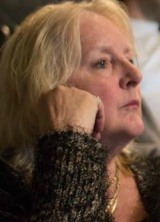 In the middle of the night in waking sleep, I asked my great-great grandmother Annie Corliss to tell me the story of how she met and married James Inglis. This story came through me in a place I have come to call the Dreamtime. The Aboriginal term feels right. As I understand it, this is not a place where the dead speak to the living but rather a space where boundaries blur as the ancestors speak in us.
In the middle of the night in waking sleep, I asked my great-great grandmother Annie Corliss to tell me the story of how she met and married James Inglis. This story came through me in a place I have come to call the Dreamtime. The Aboriginal term feels right. As I understand it, this is not a place where the dead speak to the living but rather a space where boundaries blur as the ancestors speak in us.
Annie Corliss’s Story: As It Might Have Been
My mother decided to come to America after my father died. My brother Hudson was 7 and my brother Hugh was a baby. I was 13. Mother had a little money, and she said we would have a better life in America. We left Ireland on a boat that took us to Liverpool. There we boarded the big ship Continent that took us to America. The trip took about 6 weeks. While we were at sea, first Hudson, and then Hugh died. Their bodies were wrapped in the blankets that had covered them in the filthy cabins on the ship. The priest said a few words of blessing, and they were dumped into the cold angry sea. Every day, another body was thrown overboard, sometimes two. So much grief, so many tears in the night. After Hudson died, Mother wouldn’t let go of Hugh, so afraid was she of losing him. After he died, she would not stop crying. I kept telling her she still had me. She didn’t care anymore. “America is cursed,” she kept repeating. (1)
As we set foot on land in the port of New York City she spit and cried out, “No better than Ireland.” I had to take charge. When I found the chest holding everything we brought with us, I looked around, wondering what to do. Another Irish family told us to get into a cart with them. It stopped in front of a tall building. A man carried our chests up to a small dark room where we would all stay the night. At least we were off the ship.
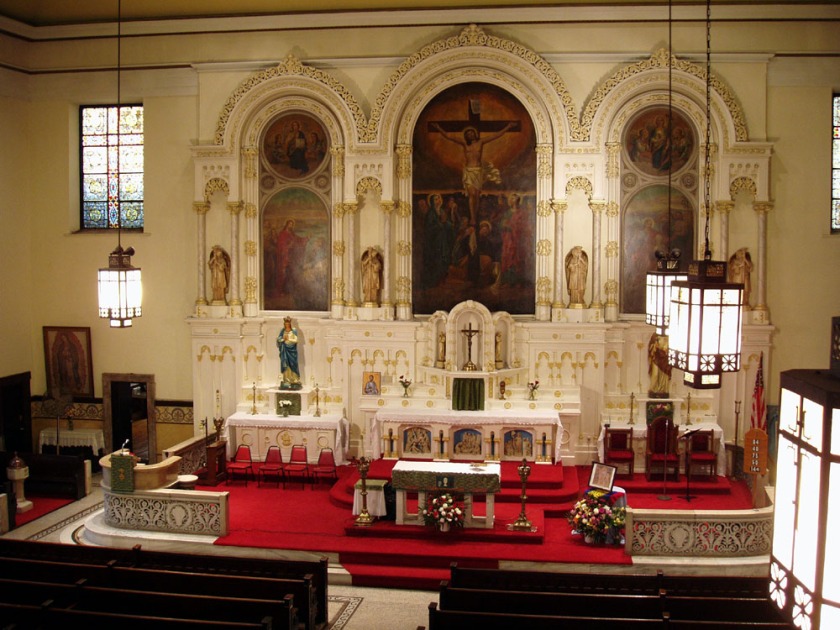
Mother never stopped crying. She said she would not eat the food of a cursed country. She died just days after our arrival. Some men came and took her body away before we even had time to wash it. They said she would be buried without a mass. No one asked me any questions, and I was too upset to say anything. “Irish trash,” I heard one of them mutter. I never knew where Mother was buried. I never visited the grave. Mrs. O’Connor took me to St. James Church to light candles for Mother’s soul. How beautiful it was. he Blessed Virgin draped in blue stood next to altar. As I prayed the Rosary, the Blessed Virgin assured me that Mother was with her. (2)
Mrs. O’Connor said I could stay on with them, if I worked to contribute to the expenses and helped with the children. When I held little Patrick, I thought of Hudson and Hugh, but I kept back my tears. The baby brought a smile to my face. Mrs. O’Connor helped me find a job washing stairs in one of the buildings nearby. She told me never to say my real age, but to tell everyone I was 16 going on 17. I had never lied before, and I feared that God would punish me, but soon I got used to lying about my age.
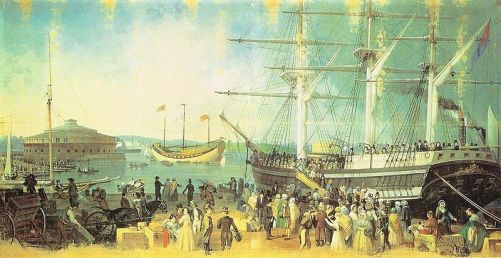 One day after work, I went down to the docks where the ships come in. Castle Garden they call it because there is a beautiful castle there. Fresh air blows in from the sea. As I was watching the people getting off the ship, I looked up and saw a boy high up on the rigging taking down the sails. He smiled at me and waved. When he finished his work, he slid down the ropes and jumped off the ship, landing in front of me.
One day after work, I went down to the docks where the ships come in. Castle Garden they call it because there is a beautiful castle there. Fresh air blows in from the sea. As I was watching the people getting off the ship, I looked up and saw a boy high up on the rigging taking down the sails. He smiled at me and waved. When he finished his work, he slid down the ropes and jumped off the ship, landing in front of me.
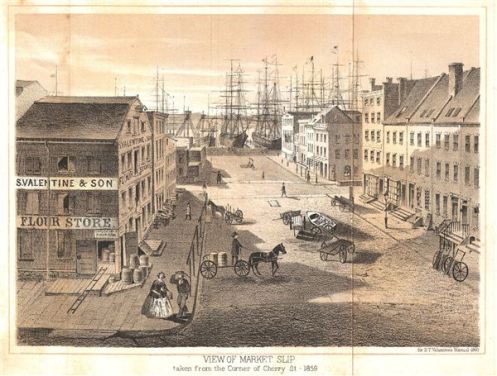 He stretched out his hand and introduced himself as James Ingalls from Scotland. He said he had been working on the ships since he was 11. “I’m 15 now and I have seen the world,” he said. Even though he was small and slight, he seemed like a man of the world to me. “I am new in America,” I said, “only a few weeks. My mother died, and I am alone.” James said he was sorry, and then he asked if I wanted to stroll around the docks with him. I thrilled when he touched my arm as we dodged out of the way of a horse and cart. We kept company until his ship left. We walked and walked. James knew so much. He showed me where it was safe and pointed to dark alleys and darkened doorways to avoid. He asked where I lived and told me he would look me up when he was in port again in about 3 months. I wondered if he would. (3)
He stretched out his hand and introduced himself as James Ingalls from Scotland. He said he had been working on the ships since he was 11. “I’m 15 now and I have seen the world,” he said. Even though he was small and slight, he seemed like a man of the world to me. “I am new in America,” I said, “only a few weeks. My mother died, and I am alone.” James said he was sorry, and then he asked if I wanted to stroll around the docks with him. I thrilled when he touched my arm as we dodged out of the way of a horse and cart. We kept company until his ship left. We walked and walked. James knew so much. He showed me where it was safe and pointed to dark alleys and darkened doorways to avoid. He asked where I lived and told me he would look me up when he was in port again in about 3 months. I wondered if he would. (3)
Mrs. O’Connor was good to me, but her husband drank too much when he got paid, and I didn’t like the way he looked at me. I told James, and he said we must make a plan to get me out of there. “We will save our money and get married,” he said. “But we are too young,” I protested. “Soon I will finish my apprenticeship, and then I will make some real money,” he insisted. “In the meantime, if we both save what we can, we can get married next year.” (4)
And that is exactly what we did. In 1855, I became Mrs. James Ingalls. I was almost 15 and James was just 17, but the priest did not bat an eyelash when we told him we were 20 and 25. He may have suspected I was pregnant, but I was not. No man ever touched me until my wedding night. The Blessed Virgin kept me safe.
James and I rented a small apartment on the 4th floor of one of those big buildings on Cherry Street where the Irish crowd together. With our small savings we bought a bed, almost like new, some sheets and blankets, a cooking pot, a kitchen sink, a coal stove, and a table and two chairs. James promised to save his wages so that we could buy more furniture when he returned. I continued to work and saved what I could. While he was gone, I bought 4 plates, only slightly chipped, with a blue and white pattern. I proudly set them on the table, hoping James would approve. Mrs. O’Connor was sure he would. (5)
Shortly after James went back to sea, I missed my monthly time. When it happened again, I knew I was pregnant. This was not part of our plan, but it was the will of God. Mrs. O’Connor said not to worry, the Blessed Virgin would protect me. (6)
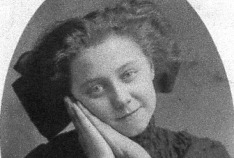 In June the census man came. He explained that he needed information about the people living in New York. James was away, so I answered the questions. James Ingalls, my husband, was at sea. I was Ann, his wife. When the man asked if I worked or was keeping house, I said “keeping house” because I was so proud to be married. When he asked our ages, I did not hesitate: “I’m 20 and he’s 25,” I said, just as we told the priest. I didn’t know if James could read or write, but I said that he could, because it sounded better, then I admitted that I could not. A few more questions and it was done: the married couple, James Ingles, 25, mariner and his wife Anne, 20, were recorded on the New York State Census. It was all real. Our life was beginning.
In June the census man came. He explained that he needed information about the people living in New York. James was away, so I answered the questions. James Ingalls, my husband, was at sea. I was Ann, his wife. When the man asked if I worked or was keeping house, I said “keeping house” because I was so proud to be married. When he asked our ages, I did not hesitate: “I’m 20 and he’s 25,” I said, just as we told the priest. I didn’t know if James could read or write, but I said that he could, because it sounded better, then I admitted that I could not. A few more questions and it was done: the married couple, James Ingles, 25, mariner and his wife Anne, 20, were recorded on the New York State Census. It was all real. Our life was beginning.
* * *
- Ann “Carless” from Ireland 13 arrived on Jan 16, 1854 in NYC from Liverpool on the Ship Continent with her mother Mary 35. I am assuming this is Ann “Corliss” because the name is spelled variously by the family and Ann herself could not read or write. Ann’s mother ‘s name is recorded Mary on her death certificate. The passenger list shows that Ann’s brothers Hudson 7 and infant Hugh died on the ship along with at least 53 of about 500 passengers. I am assuming that Ann’s father died the previous year, as he did not seem to have met them in NYC. I believe Mary died shortly after arriving as no trace of her is found in America and her daughter married so young that one assumes there was no parental supervision.
- This is a description of St. Mary’s on Grand (pictured), which was built for the Irish. I presume Mary was buried in one of New York City’s potter’s fields or pauper’s graveyards, where no names were recorded and there were no grave monuments.
- Boys were usually apprenticed as riggers at age 10 or 11.
- Without a family to protect her, young Annie would have been an easy target for sexual predators.
- See my earlier blog Life in the Tenements.
- A first child Isabella was born to James and Ann in 1855 according to 1860 census. Though the year on Isabella’s death certificate is wrong, I suspect the birth day of November 26 is correct. If Ann and James married a few months before June 1, 1855, there is no reason to assume Ann was pregnant before they married.
- On the 1855 census taken on June 1, James Ingles, mariner, and wife Anne are recorded in the Cherry Street area near the docks where they lived their whole lives. The census says he is 25 and she 20, which conflicts with the ages I have for them of 15 and 17. I believe these are my ancestors nonetheless, because they seem to have had a child later in the year and because the occupation and the location near the docks are correct. Like Annie, James could not read or write and his surname is spelled in different ways.
***
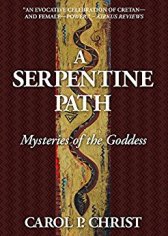 Be among the first to order A Serpentine Path, Carol P. Christ’s moving memoir of transformation. Carol’s other new book written with Judith Plaskow is Goddess and God in the World: Conversations in Embodied Theology. Carol also wrote the first Goddess feminist theology, Rebirth of the Goddess.
Be among the first to order A Serpentine Path, Carol P. Christ’s moving memoir of transformation. Carol’s other new book written with Judith Plaskow is Goddess and God in the World: Conversations in Embodied Theology. Carol also wrote the first Goddess feminist theology, Rebirth of the Goddess.
Join Carol on a Goddess Pilgrimage to Crete in 2017. Save $200.
Read two of the chapters in the book: Mysteries and Dionysian Rites.
Thanks to Judith Shaw for the cover art “Downward Serpent.”


What a beautiful expression of the spirit, humor and sweetness that comes through in the photograph of Annie Corliss. I resonate with your understanding of Dreamtime as the place “where boundaries blur as the ancestors speak in us.” Thank you for sharing Annie’s voice with us. Dream on!
LikeLike
She was so young and so innocent, yet she survived and thrived.
LikeLike
I love these stories, because by 7 times great grandmother (direct maternal line) came over from Ireland in 1794!
LikeLike
You’re turning fairly dry history (census documents, etc.) into a living story. Wondeful! I bet we’ll hear more of it.
LikeLike
Thank you for another chapter of this amazing story, Carol.
I can feel these people, their spirits gathered around you, appreciating and loving your work….all of it – for women, for refugees, for justice.
LikeLiked by 1 person
This is a challenging post, Carol, because there’s so much pain lingering in the background here along with the grief.
On loss and depression, my longtime partner died a couple of years ago, and I’m still not sane. But I was sitting alone in a New York City cafe yesterday reading a newspaper and a young woman I’ve never met before came up to me, kissed me tenderly on the cheek for a moment and left. That’s never happened to me before. The girl was probably no more than maybe 25 years old, and she could easily have been my daughter.
Anyway it made my day for sure. But it seems to me also that the younger generation these days has a lot more chutzpah maybe than my generation had, and between women, I think there is now much more compassion. When I was young I was ready to march, and I did join the marches, but kissing a stranger on the cheek to cheer them up would never have occurred to me.
LikeLiked by 1 person
Thank you for this amazing story, bringing to life these people of such courage and faith! I think most of us have no idea what our ancestors went through to make better lives for the generations who came after them, for us, or the gratitude we owe them. It is wonderful that you are honoring your ancestors in this creative, loving way.
LikeLiked by 1 person